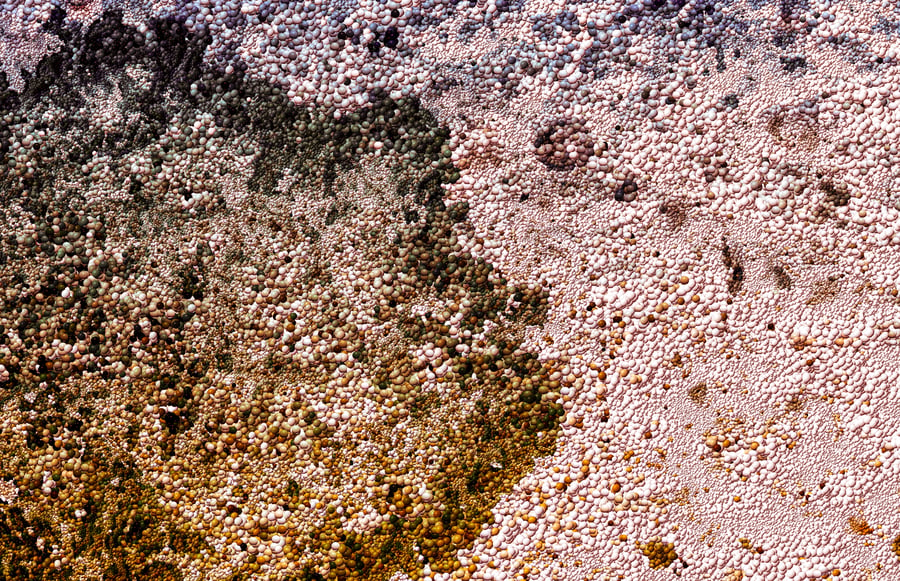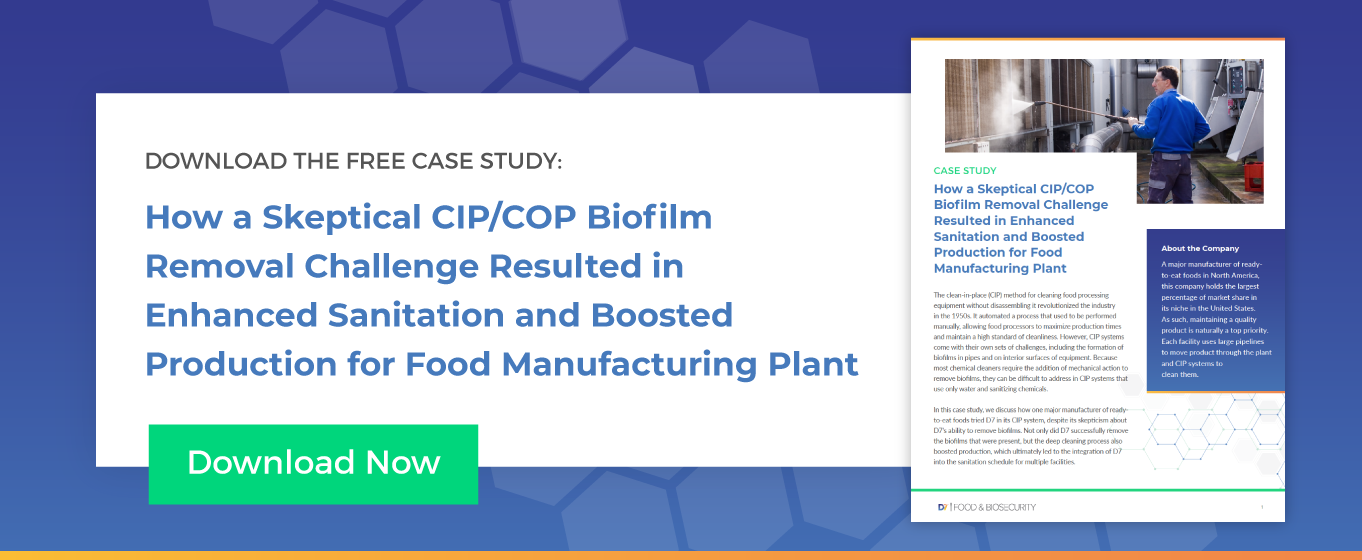
First discovered in the 17th century by the inventor of the microscope, biofilms have been a challenge in the food processing industry since before they were even fully understood. Now that researchers better understand how biofilms form and thrive, new approaches are being developed to address them.
Biofilm Removal Challenges
Some of the factors that contribute to the growth of biofilms in a facility are equipment design, small spaces between machinery, and difficult-to-reach areas, such as drains and inside pipelines. Even with sanitation protocols in place, bacteria can find areas to adhere to and start the biofilm formation process. Once formed, a biofilm becomes more difficult to remove than free-floating bacteria because of the protective matrix surrounding it. Biofilms are also invisible to the naked eye, which means FSQA managers rely on regular testing to identify their presence.
In many cases, removing biofilms requires physically disrupting the protective matrix with mechanical action. Because they can’t be seen, this means scrubbing literally every surface in a facility. A diversity of bacterial species, both within facilities and within biofilms themselves, adds to the challenge because disinfecting approaches must be able to address all of the bacteria in the colony. Individual behavior of facility personnel is also a risk factor when it comes to the formation of biofilms. Glove changes, travel between sanitation zones, and moving equipment are all opportunities to transport bacteria.
Approaches to Biofilm Removal
Preventive controls are clearly the best way to avoid biofilms in a food processing environment, but because of the challenges stated above, biofilm treatment is sometimes required. Some of the different approaches to biofilm removal include:
Chemical Disinfectants
Killing the bacteria within a biofilm requires a disinfectant. Some of the chemical disinfectants used to address biofilms include:
- Acidic compounds
- Aldehyde-based biocides
- Chlorine
- Hydrogen peroxide
- Iodine
- Isothiazolinones
- Ozone
- Peracetic acid
- Phenolics
- Biguanides
- Quaternary ammonium compounds
All of these products must be combined with mechanical action to effectively penetrate and remove a biofilm.
Surface Modification
One approach to avoiding biofilms in the first place is surface modification to prevent and limit the adhesion of bacteria to work areas and equipment. This might include:
- Nanoparticles with different metal oxides
- Nanocomposites
- Antimicrobial polymers
- Hydrogels or liposomes
Cell-signaling Inhibition Strategies
Lactic acid and different types of citric acids can be used to disrupt the cell-to-cell communication between bacteria, limiting their ability to form biofilms.
Enzymatic Disruption Strategies
Biofilm control has been achieved by incorporating enzymes into the detergents used to clean or pre-treat food processing facilities. Some of the enzymes used include:
- Cellulases
- Proteases
- Glycosidases
- DNAses
Non-thermal Plasma Treatments
Non-thermal plasma is a partially ionized, low-temperature gas that has antimicrobial properties. It’s created by mixing UV light with oxygen, nitrogen, ozone, water, and helium under an electrical discharge and can destroy bacterial biofilms in a relatively short period of time. However, its use is limited because it is a costly approach.
Bacteriophages
Bacteriophages (such as P100) provide an antimicrobial effect that is harmless to plants and animals because they specifically target prokaryotic cells. Each bacteriophage targets a specific pathogen species, so it’s important to know which bacteria are present in the biofilm for this approach to be effective.
Bacteriocins
Nisin spray is used in the food processing industry to prevent the adhesion of Listeria monocytogenes biofilms. Other bacteriocins are currently under investigation for similar applications.
Biosurfactants
Biosurfactants are natural compounds that modify the characteristics of bacteria to make them less able to adhere to surfaces. Some of the compounds that have been used in the food processing industry include:
- Lichenysin
- Surfactin
- Fengycin
- Iturin
Plant Essential Oils
Some plant essential oils have been shown to have antibiofilm properties, including those that contain:
- Cinnamaldehyde
- Thujone
- Camphor
- Pinene
- Citral
- Carvacrol
How D7 Compares to Alternate Methods
D7 is a formula that relies on a combination of multiple mechanisms to defeat pathogenic targets. While most products depend upon a single mechanism, D7 uses:
- Oxidation via hydrogen peroxide
- Oxidation via peracetic acid
- Oxidation via percarbonates
- Membrane disruption and subsequent lysis using quaternary amines
- Protein denaturation using safe solvents
- Chemical attack using strong nucleophiles promoted by micellar catalysis
- Detergency action to soften up difficult-to-remove, water-resistant films
D7 is not simply another quaternary ammonium compound or disinfectant; it is a decontamination system that vigorously attacks biofilms.
Unlike other chemical disinfectants, D7 does not require mechanical action for biofilm removal. This saves on manpower and reduces the time required for biofilm treatment, so facilities can return to production more quickly. D7 is also safe to use on the most common types of surfaces found in food processing facilities, including stainless steel, sealed wood, glass, and rubber. Many other disinfecting chemicals and strategies are corrosive or only work on certain types of surfaces.
Some microbes have been shown to build a resistance to sanitizing chemicals, such as chlorine and quaternary ammonium compounds, which are two of the most widely used in the industry. Although this can be combated by rotating the use of various sanitizing chemicals, this approach can be confusing for sanitation crews and requires additional chemical storage and organization. Some chemicals, such as formaldehyde, require the facility to be at a certain temperature in order to be effective, while others must be delivered with steam. Although effective, these processes can be costly and time-consuming.
D7 for Biofilm Prevention and Removal
Biofilms will always be a challenge in any food processing environment. However, with preventive controls and daily sanitation protocols that bring bacteria to safe levels, the chances of biofilm formation can be reduced. When biofilms do form, they can be safely and effectively removed with a single product: D7.
The patented chemistry behind D7 allows it to penetrate biofilms and kill bacteria without mechanical action. The product is safe to use, easy to apply, and cost-effective when compared to other options that require more manpower or longer application processes. To learn more, read The Busy FSQA Manager’s Guide to Proactive Plant Sanitation.


